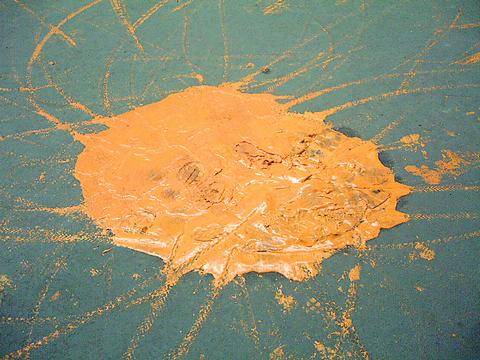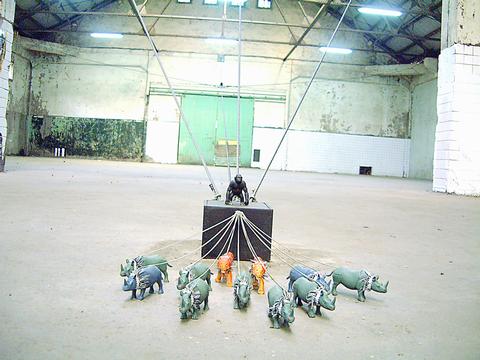Taipei Times: You're fresh from your co-curatorship of the international Taipei Biennial 2000. How has that experience informed your aesthetic choices for "Orange Marble?"
Manray Hsu: One thing I've noticed throughout my travels around the world, is that the art academy produces "serious" artists who make rather humorless and lifeless art. "Orange Marble" shows that playfulness and humor are valid responses to the contradictions, absurdities and stresses of life.

PHOTO COURTESY OF MANRAY HSU
TT: How so?

PHOTO COURTESY OF MANRAY HSU
MH: Well, art is an attitude to life, while convention is the most dangerous situation of our lives. Convention lulls us into thinking that life should be a certain way. We falsely believe that it provides us the easiest solution for the human condition when in fact it does not. So the real point of making art is what it can provide us. Art that goes against convention gives us a new way to look at our world and offers us innovative ideas on how to cope.
TT: The idea of this show then is to pose playfulness against convention?

PHOTO COURTESY OF MANRAY HSU
MH: Yes. The artists are playful and go against the conventions of art and of life.
TT: Despite the cultural differences of the artists, what do they share?
MH: They share a certain attitude responding to the ridiculousness and cruelty of the world expressed through artistic means.
TT: So are you saying the artists are taking a cynical stance against an absurd world?
MH: There are two senses of cynical: one is to admit a self-defeating position by doing nothing and the second is to really see what is going on, but make a gesture toward the world.
In this case, Daniel Olson uses the image of a circus clown. Clownish humor provides inspiration for us on how to deal with this crazy world. So send in the clowns.
The title "Orange Marble" is so visual. What does it refer to?
MH: title alludes to what art is about. Orange is an unconventional color while a marble is small, shiny and rolls around. To me, a child playing with a marble is very inspiring; it is a moment of real playfulness. Also, because "losing one's marbles" implies going mad, having an artistic marble in one's head is perhaps the most sane way to face our world.
TT: Which artwork epitomizes the spirit of "Orange Marble?"
MH: Chen Sheng-chih (陳昇志) threw homemade bombs made with gaoliang rice wine into a firepit for a piece called Oh Angel. My Bomb!. His title is a play on words. Angel is a condition that humanity aspires to; yet at the same time, Chen felt the [English] word for angel sounds similar to the [English] word anger. Anger is a basic human sentiment. According to Buddhism, we live in the fire of anger. Chen wants to convey the idea that the world is in such a mess, and that we not only have anger against this messed-up world, but we must suppress our anger. His work plays with the meanings of both English and Chinese words. It was a performance where the audience did not know the outcome and it was both funny and serious at the same time.
TT: In your exhibition statement, you refer to the ancient Chinese story of a man who claimed the earth and sky were his house, and his house was his clothes. How does this story relate to the show?
MH: That story of a Chinese Taoist intellectual from the fifth or sixth century is quite interesting. One day, his friend came to his house and saw him naked. His friend said, "You are offensive, inviting me here, but greeting me naked." The intellectual replied, "The whole universe is my house and my mansion is my clothing. You are entering my clothing."
This Taoist is aware of the relativity of shelter. We think we need a big shelter to protect us from chaos. We feel sheltered by things such as national identity, borders, stereotypes, professions, groupings.
TT: Or by convention?
MH: Exactly. "Orange Marble" artists think along similar lines to this Taoist. They take the security out of the box, change their awareness of shelter and see things in a new way. This universal attitude to get out of the box exists in all cultures and can be found in literature, art and philosophy.
TT: So the Taiwanese and Canadian artists share this universal attitude and this is what links them together?
MH: Yes, even though they have markedly different cultural experiences and backgrounds, these artists, in being artists, follow the heritage of non-conventional and philosophical thinkers. Their basic language of art allows them to communicate easily with each other and the audience. Michael Buckland's hilarious performances and Kelly Richardson's videos of banal moments hit your funny bone and help you see things a bit differently.
TT: The artists have all been eager to collaborate with each other. Yet, the Canadian artists are only here for one week. What kind of synergy will happen?
MH: Ideally, to create a cross-cultural international exchange requires money to have the artists live and work together for a month or two. However, due to lack of funding and time, this is not always feasible. That is why the curator has become so important over the past few years. The curator plays a vital role, functioning as the bridge between the different artists.
TT: What is your vision with "Orange Marble?"
MH: First, I don't think a show like this can do too much. In the past few years, the Taiwan art world has gotten conservative. Playfulness and lightheartedness is really lacking in art shows here. Artists wanting to be treated as serious artists, think they must make serious art that lacks humor or playfulness. But, as Chen Sheng-chih?aid: "When normal people are putting vibrating cellphones into their body orifices, and artists are putting `fine,' albeit stale art, in museums; then, who is really the avant-garde?"
TT: Can you speak a bit about the Taiwanese artists?
MH: Lin Hong John (林宏璋 is able to refer to Chinese traditional ink landscape painting, Western entertainment culture and Taiwan's cultural paradox in Shrink Nature and Magnify Oneself. He superimposes flags and golf clubs onto a traditional ink painting, and his video shows people garbed in traditional Chinese clothing and playing golf in a mock Chinese garden.
Tang Huang-chen's (蔡皇珍) Green Bubbles, an actual wooden maze, resembles the Chinese character for whirlpool (游渦). This refers to drunkenness since the space was a winery, but it mainly refers to cultural exchange. Any kind of exchange takes time and care like making wine, and can help alter one's perceptions.
TT: What do you expect of the show?
MH: I expect a hostile or indifferent reaction from the established art world. However, like what I saw at the Taipei Biennial, I believe the average viewer will interact with the art and have a fantastic time.
Hwa-shang Art District will host a party on March 24 with a drum circle, DJs and a barbecue at which artist Chen Sheng-chih will be present.
For your information
What: Orange Marble
Where: Hwa-Shang Art District, 1 Pate Rd., Sec. 1, Taipei (臺北市八德路一段1號); tel 2392-6180
When: Until March 31

On April 26, The Lancet published a letter from two doctors at Taichung-based China Medical University Hospital (CMUH) warning that “Taiwan’s Health Care System is on the Brink of Collapse.” The authors said that “Years of policy inaction and mismanagement of resources have led to the National Health Insurance system operating under unsustainable conditions.” The pushback was immediate. Errors in the paper were quickly identified and publicized, to discredit the authors (the hospital apologized). CNA reported that CMUH said the letter described Taiwan in 2021 as having 62 nurses per 10,000 people, when the correct number was 78 nurses per 10,000

As we live longer, our risk of cognitive impairment is increasing. How can we delay the onset of symptoms? Do we have to give up every indulgence or can small changes make a difference? We asked neurologists for tips on how to keep our brains healthy for life. TAKE CARE OF YOUR HEALTH “All of the sensible things that apply to bodily health apply to brain health,” says Suzanne O’Sullivan, a consultant in neurology at the National Hospital for Neurology and Neurosurgery in London, and the author of The Age of Diagnosis. “When you’re 20, you can get away with absolute

May 5 to May 11 What started out as friction between Taiwanese students at Taichung First High School and a Japanese head cook escalated dramatically over the first two weeks of May 1927. It began on April 30 when the cook’s wife knew that lotus starch used in that night’s dinner had rat feces in it, but failed to inform staff until the meal was already prepared. The students believed that her silence was intentional, and filed a complaint. The school’s Japanese administrators sided with the cook’s family, dismissing the students as troublemakers and clamping down on their freedoms — with

As Donald Trump’s executive order in March led to the shuttering of Voice of America (VOA) — the global broadcaster whose roots date back to the fight against Nazi propaganda — he quickly attracted support from figures not used to aligning themselves with any US administration. Trump had ordered the US Agency for Global Media, the federal agency that funds VOA and other groups promoting independent journalism overseas, to be “eliminated to the maximum extent consistent with applicable law.” The decision suddenly halted programming in 49 languages to more than 425 million people. In Moscow, Margarita Simonyan, the hardline editor-in-chief of the